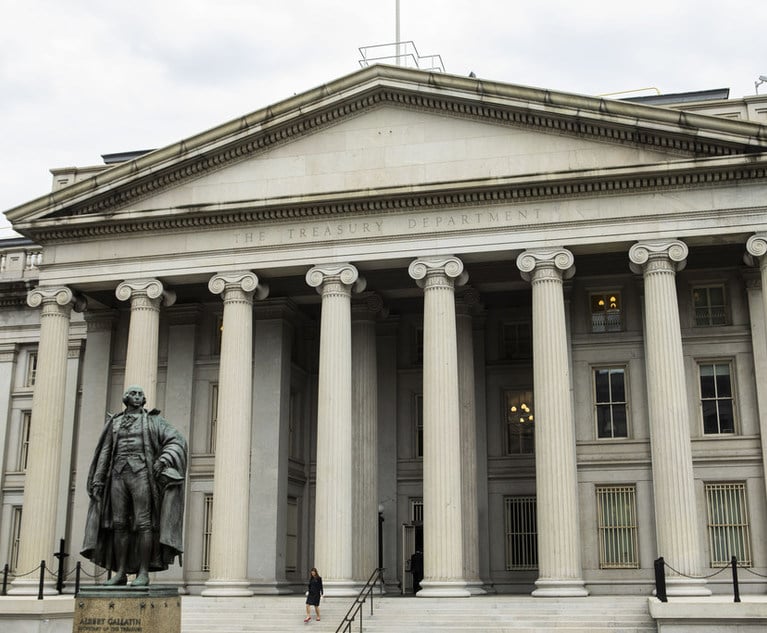A Year Later, African-American Museum Gives a Nod to Clarence Thomas
After criticism, the National Museum of African American History and Culture in Washington has featured U.S. Supreme Court Justice Clarence Thomas in a new display on the court.
September 26, 2017 at 01:24 PM
3 minute read
Without fanfare, the National Museum of African American History and Culture in Washington has featured U.S. Supreme Court Justice Clarence Thomas in a new display about the court alongside the late justice Thurgood Marshall.
The new installation was added shortly before the museum marked its first anniversary September 24, and may or may not end a long-simmering controversy over the museum's treatment of Thomas.
Before the addition, the only reference to Thomas, the second African-American justice in history, was in a display about Anita Hill, who accused Thomas of sexual harassment during his confirmation hearing in 1991.
Conservative groups and members of Congress including Sen. R. Ted Cruz, R-Texas complained about the omission, accusing the museum's leaders of political bias. Cruz wrote to Smithsonian officials last December that “I became deeply disturbed upon learning that Justice Thomas's moving story and incredible contributions to the country are not even mentioned, much less discussed in detail, in the new museum.”
Smithsonian spokeswoman Linda St. Thomas confirmed the installation, noting that Marshall had not been depicted previously for his position as a Supreme Court justice, but rather as the attorney who argued Brown v. Board of Education. The new display recognizes both justices for their role on the high court.
The Smithsonian did not formally announce the exhibit. St. Thomas said the institution does not typically issue news releases about individual exhibits. The Washington Times reported on the installation on Monday.
The glass-enclosed display includes photos of both justices and written histories titled: “Thurgood Marshall: Civil Rights Lawyer to Supreme Court Justice,” and “Clarence Thomas: From Seminary School to Supreme Court Bench.” Photos of Thomas as a student at the College of the Holy Cross and on the cover of Jet Magazine were part of the exhibit.
The display includes Marshall's eyeglasses and a watch, but no objects from Thomas. Asked if Thomas discussed or cooperated with the museum about the exhibit, St. Thomas said she did not know.
At the height of the controversy over Thomas's treatment last year, Smithsonian secretary David Skorton said in a statement, “While we recognize that we cannot tell every story in the inaugural exhibitions of our newest museum,” new exhibitions would be added and “we expect that Justice Thomas's story will be an excellent illustration of one of the themes that exemplify that [African American] experience.”
This content has been archived. It is available through our partners, LexisNexis® and Bloomberg Law.
To view this content, please continue to their sites.
Not a Lexis Subscriber?
Subscribe Now
Not a Bloomberg Law Subscriber?
Subscribe Now
NOT FOR REPRINT
© 2025 ALM Global, LLC, All Rights Reserved. Request academic re-use from www.copyright.com. All other uses, submit a request to [email protected]. For more information visit Asset & Logo Licensing.
You Might Like
View All
Trump Seeks Pause of Supreme Court Cases, Disavows DOJ Stance on Voting Rights Act

Supreme Court Takes Up Case Over Approval of Religious Charter School

Supreme Court Reinstates Corporate Disclosure Law Pending Challenge

Supreme Court Considers Reviving Lawsuit Over Fatal Traffic Stop Shooting
Trending Stories
- 1Cornell Claims AT&T, Verizon Violated the University's Wi-Fi Patents
- 2OCR Issues 'Dear Colleagues' Letter Regarding AI in Medicine
- 3Corporate Litigator Joins BakerHostetler From Fish & Richardson
- 4E-Discovery Provider Casepoint Merges With Government Software Company OPEXUS
- 5How I Made Partner: 'Focus on Being the Best Advocate for Clients,' Says Lauren Reichardt of Cooley
Who Got The Work
J. Brugh Lower of Gibbons has entered an appearance for industrial equipment supplier Devco Corporation in a pending trademark infringement lawsuit. The suit, accusing the defendant of selling knock-off Graco products, was filed Dec. 18 in New Jersey District Court by Rivkin Radler on behalf of Graco Inc. and Graco Minnesota. The case, assigned to U.S. District Judge Zahid N. Quraishi, is 3:24-cv-11294, Graco Inc. et al v. Devco Corporation.
Who Got The Work
Rebecca Maller-Stein and Kent A. Yalowitz of Arnold & Porter Kaye Scholer have entered their appearances for Hanaco Venture Capital and its executives, Lior Prosor and David Frankel, in a pending securities lawsuit. The action, filed on Dec. 24 in New York Southern District Court by Zell, Aron & Co. on behalf of Goldeneye Advisors, accuses the defendants of negligently and fraudulently managing the plaintiff's $1 million investment. The case, assigned to U.S. District Judge Vernon S. Broderick, is 1:24-cv-09918, Goldeneye Advisors, LLC v. Hanaco Venture Capital, Ltd. et al.
Who Got The Work
Attorneys from A&O Shearman has stepped in as defense counsel for Toronto-Dominion Bank and other defendants in a pending securities class action. The suit, filed Dec. 11 in New York Southern District Court by Bleichmar Fonti & Auld, accuses the defendants of concealing the bank's 'pervasive' deficiencies in regards to its compliance with the Bank Secrecy Act and the quality of its anti-money laundering controls. The case, assigned to U.S. District Judge Arun Subramanian, is 1:24-cv-09445, Gonzalez v. The Toronto-Dominion Bank et al.
Who Got The Work
Crown Castle International, a Pennsylvania company providing shared communications infrastructure, has turned to Luke D. Wolf of Gordon Rees Scully Mansukhani to fend off a pending breach-of-contract lawsuit. The court action, filed Nov. 25 in Michigan Eastern District Court by Hooper Hathaway PC on behalf of The Town Residences LLC, accuses Crown Castle of failing to transfer approximately $30,000 in utility payments from T-Mobile in breach of a roof-top lease and assignment agreement. The case, assigned to U.S. District Judge Susan K. Declercq, is 2:24-cv-13131, The Town Residences LLC v. T-Mobile US, Inc. et al.
Who Got The Work
Wilfred P. Coronato and Daniel M. Schwartz of McCarter & English have stepped in as defense counsel to Electrolux Home Products Inc. in a pending product liability lawsuit. The court action, filed Nov. 26 in New York Eastern District Court by Poulos Lopiccolo PC and Nagel Rice LLP on behalf of David Stern, alleges that the defendant's refrigerators’ drawers and shelving repeatedly break and fall apart within months after purchase. The case, assigned to U.S. District Judge Joan M. Azrack, is 2:24-cv-08204, Stern v. Electrolux Home Products, Inc.
Featured Firms
Law Offices of Gary Martin Hays & Associates, P.C.
(470) 294-1674
Law Offices of Mark E. Salomone
(857) 444-6468
Smith & Hassler
(713) 739-1250








